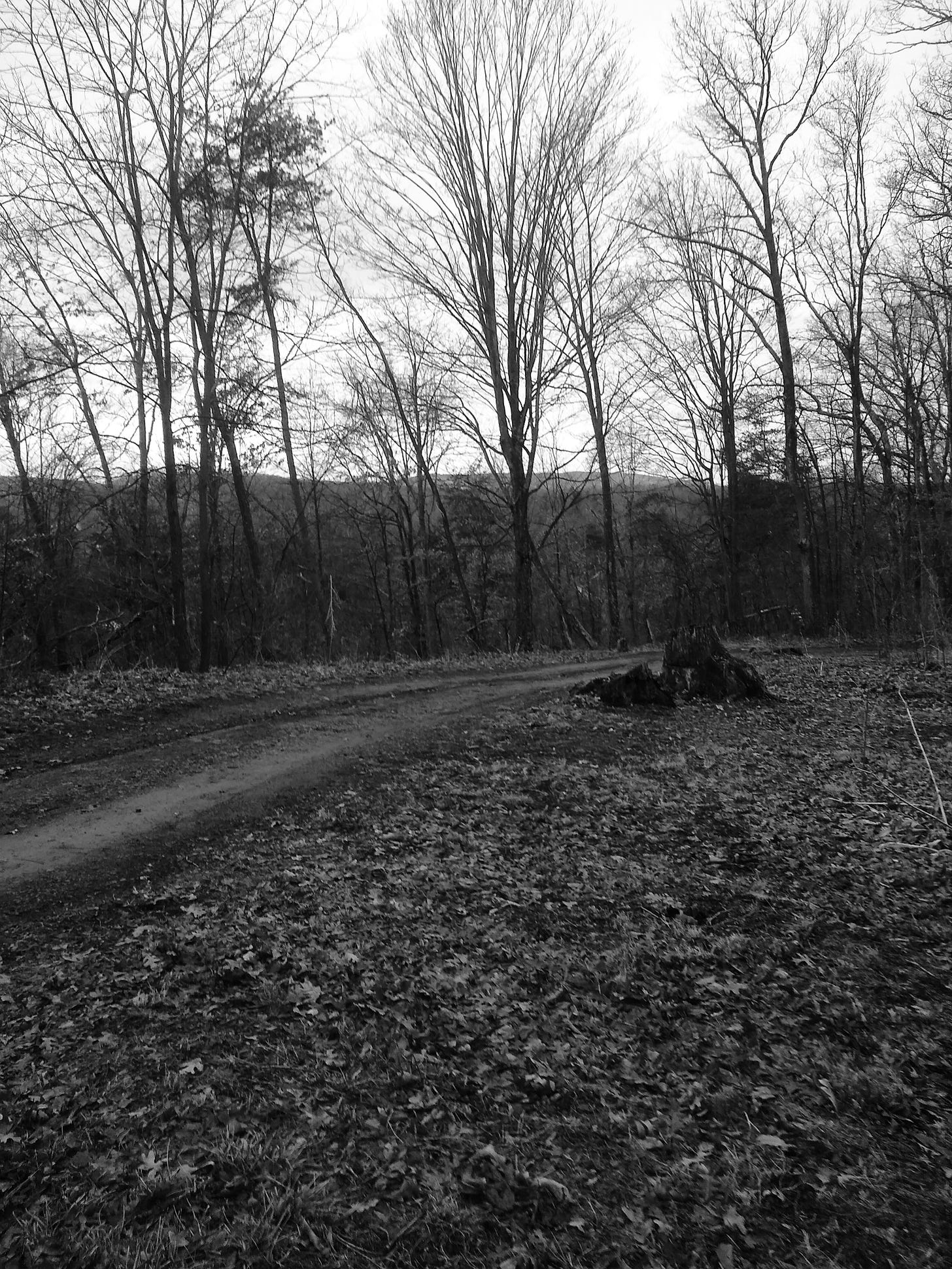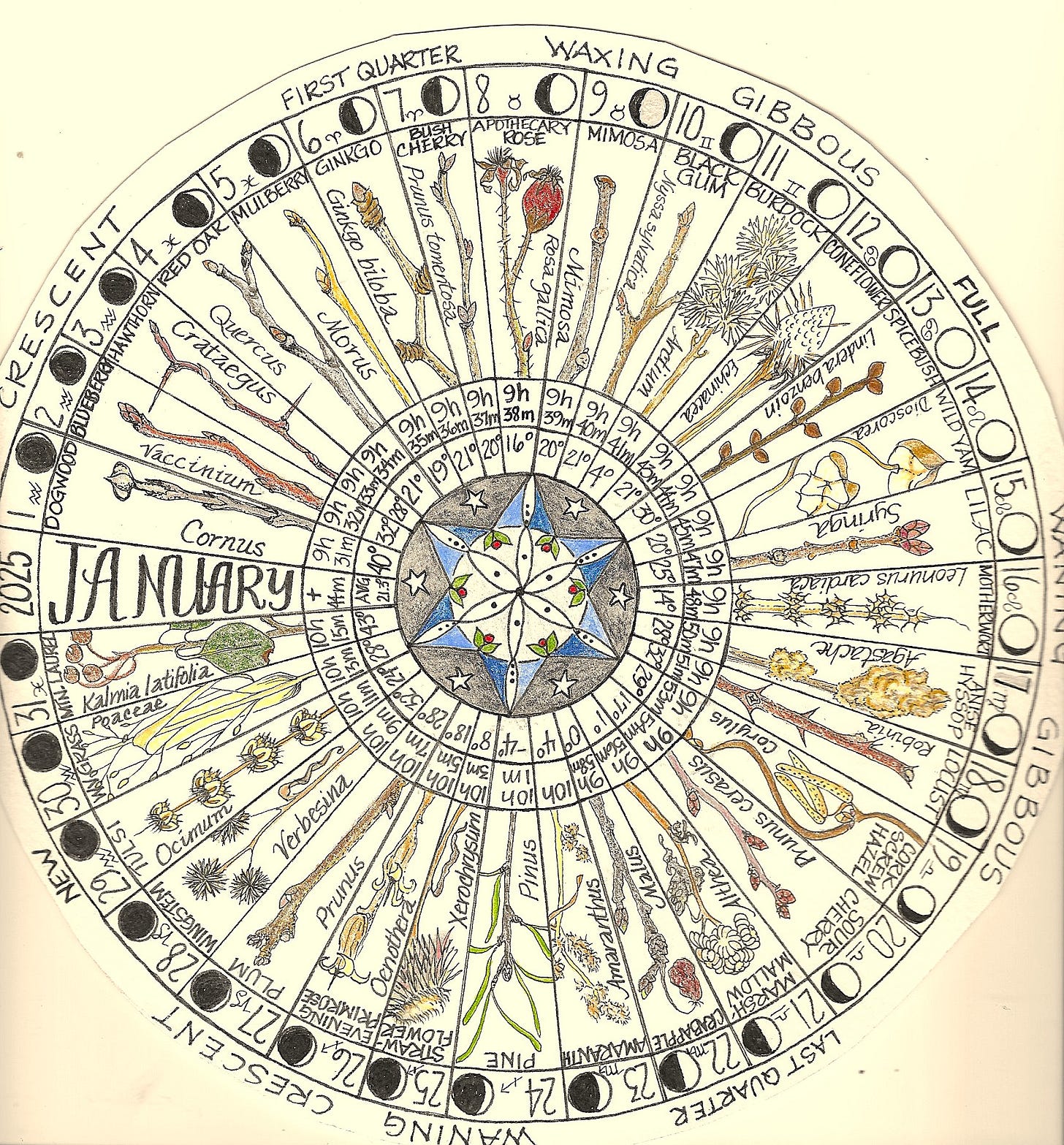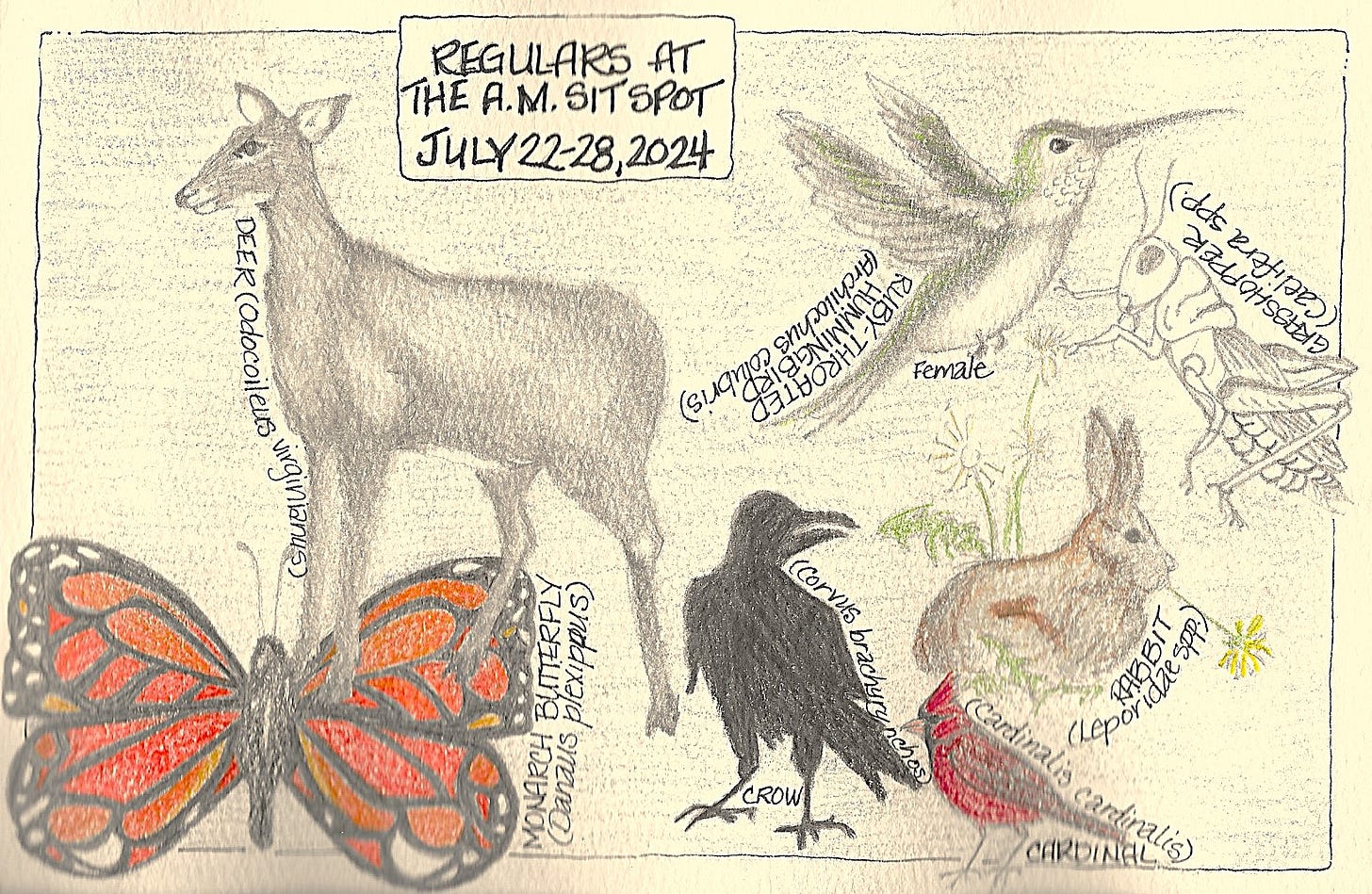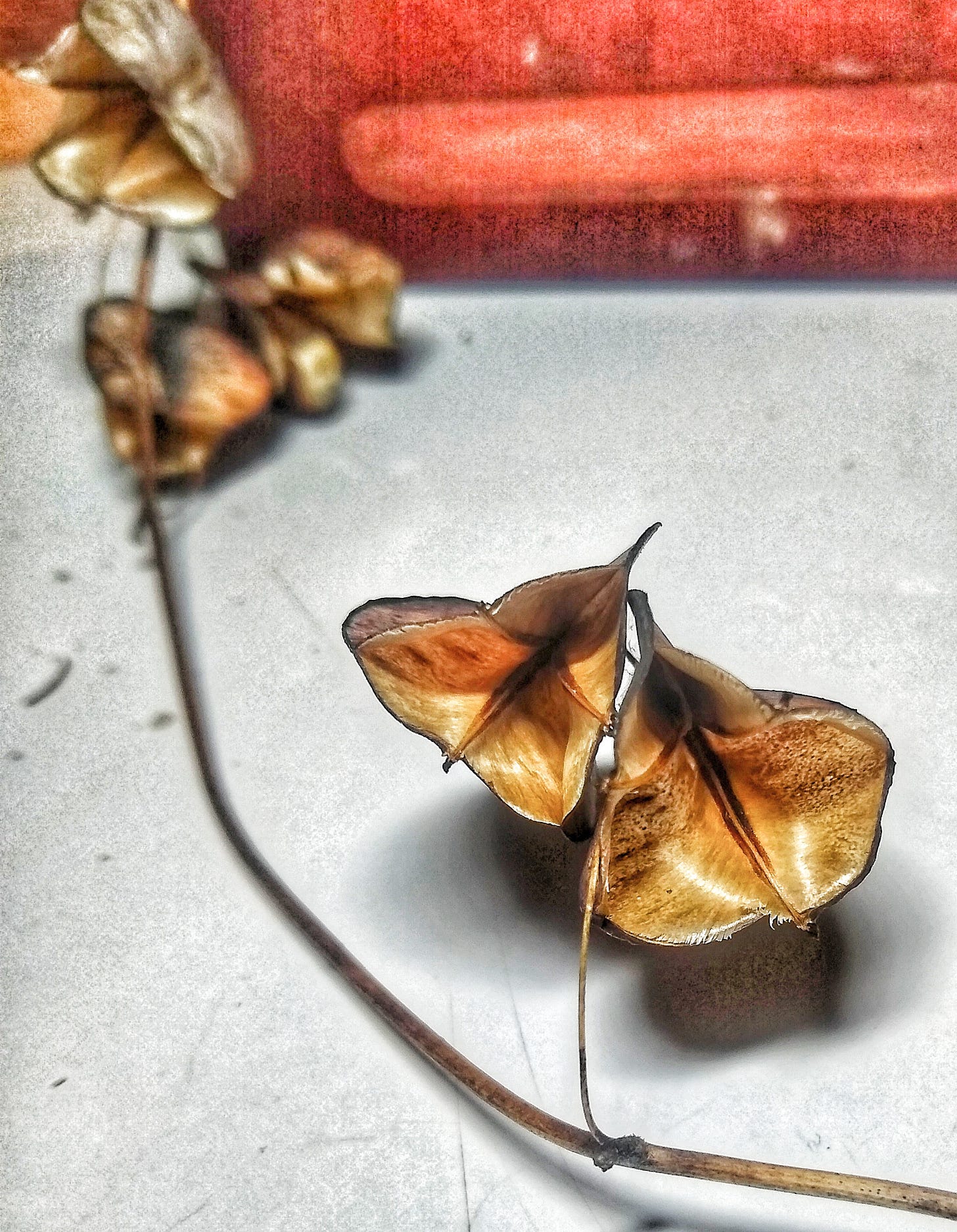Is the winter world really lifeless? That’s the question I posed to myself when I started my January Phenology wheel, inviting myself to take a closer look at ‘Twigs.’
It can be easy to assume that winter is a monochromatic season, especially when we only give nature a cursory glance through as window or as it whizzes by our vehicles. But one of the opportunities of winter from Nature’s point of view is to slow down and notice the details. It’s a wonderful time, if you can carve out even 20 or 30 minutes a day to look closely at the apparent dull uniformity of the resting natural world. I discovered, with fascination, that it springs to life and infinite colors bloomed before my eyes when I did.
When I chose ‘Twigs’ as my focus for the month, I initially thought it would be an opportunity to learn to identify more trees and shrubs during their dormancy. I did a little of that, using a Winter Botany botanical key. But mostly I left that book on my desk and learned directly from the myriad plant teachers available right outside my door. As you can see by my January Phenology wheel, a lot was going on in those woods I thought were all gray and brown.
My Phenology wheel is just a snick too wide for my scanner but the important details are visible. I used cold pressed 140 lb. watercolor paper, Faber-Castell Polychromos colored pencils, and black ink.
In January the days lengthened by 44 minutes and the average temperature at my home in the mornings was 21.3 degrees Fahrenheit. I didn’t originally plan to do this but I ended up composing a haiku for the month, which was really enjoyable and I will probably continue. Here is January’s:
Drab branches fake death.
Superficialities---
Look close to see truth.
Phenology sounds like an obscure branch of science, which I suppose it is to some folks. To me, it’s a daily practice of noticing that grounds me in the real, biological world and the many wonders and beauties of Nature. That’s something I truly need right now. Despite the shifting sands of culture and politics, I can still step outside my door, slow down, and take time to make note of the changes from day to day.
Phenology comes from the Greek phaino, which means to show, to bring to light, make appear. Thomas J. Elpel, author of BOTANY IN A DAY: The Patterns Method of Plant Identification and SHANLEYA’S QUEST: A Botany Adventure for Kids Ages 9 to 99, observes that humans often perceive nature as the wallpaper or background for the main act or performance of their lives, rather than a living, dynamic web of species all living out their lives simultaneously. Phenology, like Alice in Wonderland’s looking glass, invites us to step into the “wallpaper” to discover a magical world that has existed right alongside of us humans all along.
Unlike some of the assignments that your science teachers may have given you in your school days, Phenology is not rocket science. I’ll venture to say that you’ve probably already participated in it many times without realizing it. For example, have you ever checked out the wooly bear caterpillars in autumn to see how relatively wide or narrow their brown and black bands are as a way of forecasting the severity of the winter ahead? Or perhaps you’ve commented on the earliness or lateness of the arrival of the first robin heralding spring? Or maybe an elder gardener in your family or community has advised you to plant half-hardy vegetables like leafy greens when the daffodils bloom or to plant potatoes when the first Dandelions bloom? All of these, and many more, are facets of Phenology. Traditional gardening lore is riddled with Phenology because it has always been important to our survival to know the right time to plant, harvest, travel, and begin or complete all sorts of projects.
In the modern world we look to abstractions like calendars and clocks to tell us what to do when and sadly, these tools, practical as they are, make no allowances for seasons and natural cycles. Anyone who takes the time to notice knows that we are different people in summer than we are in winter; that each season calls for different clothing, activities, foods, and choices. But jobs, schools, and more appear to believe that we should continue in the same way in January as we do in June. Imagine the catastrophe if birds or trees tried to do that!
I’ve made note of the natural phenomena in my herb journals over the years, sometimes with words and sometimes with images. Sometimes with both. Back in November 2024, just two months ago, I came across a video of an artist in the UK who was making a phenology wheel, one for each month. Marion’s World is a YouTube channel and I’m sharing the link to her Phenology wheel tutorials. The first one is while she was still working her way through each month and the second one includes her process of binding all twelve of her wheels into a beautiful book. Each is about 30 minutes long.
Marion began taking short nature walks as she was grieving the loss of her partner. She decided to focus on one small aspect of the natural world each day for a month and record it on her wheel. If you watch her videos and listen to her story, you’ll see what an impact it had on her life.
I’ve decided to take it one month at a time and create my own phenology wheels. I don’t know if I will make it all year, but I am setting out with that intention. The wheel was surprisingly quick to construct, only about 15 minutes, and all I needed was a piece of paper, a compass, and a pencil. Marion’s method is so easy and requires no mathematical calculations. Each wedge of the wheel is so small that it only takes about 5-10 minutes each day to draw something, along with the temperature and day length. So, obviously no aspect of this is particularly time-consuming. Even if I include my time outdoors, it’s well under an hour, often less than 30 minutes, total. The benefits far outweigh the time investment.
Like many, I’m experiencing a lot of stress currently so I’m making every effort to be intentional about how I spend my time and what I give my attention to. Every aspect of nature is a balm for me. I fill the bird feeders and am nourished by watching the birds go about the business of making their lives. I walk with my dog, Athena, and we notice what the squirrels and rabbits have been up to, what the chipmunks and the wind has to teach.
Initially, I debated what I would observe and draw for January, but I finally settled on ‘Twigs.’ At first glance a winter landscape looks so austere and monochromatic. That’s only when I am standing at a distance and looking at it as if it were “wallpaper.” As an outside observer, I’m glimpsing an overall pattern and overlooking all the details. From the very first day (Dogwood), I’ve been fascinated to discover that all those seemingly interchangeable sticks and twigs are each utterly unique. The bark textures, colors, and bud arrangements are as unique as their leaves in summer and autumn.
At one point I began gathering stalks of herbs and flowers, fat now with seeds that are feeding the birds and wildlife. Some, like Wild Yam, were more beautiful in their dormancy than they were in this vibrant flush of growth in summer.
Wild Yam (Dioscorea villosa)
Wishing you many wonderful winter adventures and fun discoveries with phenomenal phenology. Please feel free to share your favorite folk weather lore or memories in the comments.









Such an important subject to help us understand climate change, for those living in the UK, you can join citizen science Nature's Calendar ( via WoodlandTrust website) and upload observations
I discovered this concept recently. I was fascinated by this mapping project as I followed the signs of autumn on it. Spring should be more fun. It is also a concrete measure of climate change year to year: https://www.usanpn.org/data/maps/spring